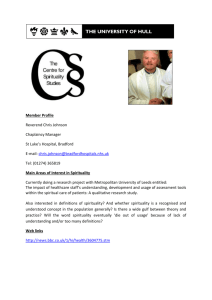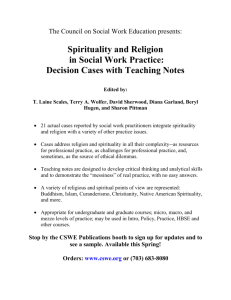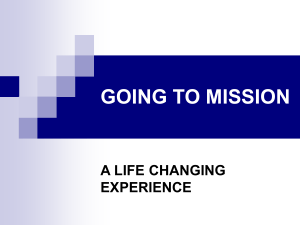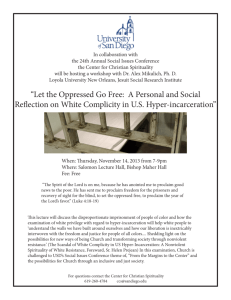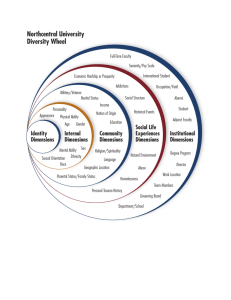Religion and Physical Health
advertisement
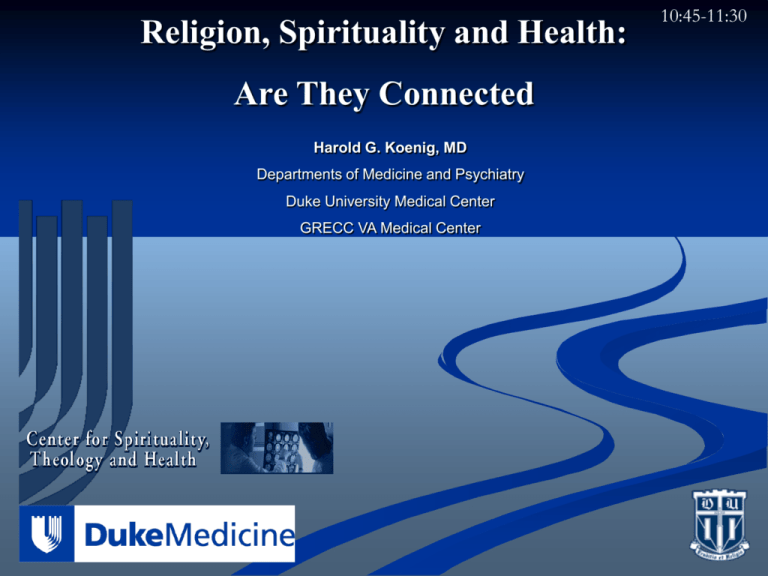
Religion, Spirituality and Health: Are They Connected Harold G. Koenig, MD Departments of Medicine and Psychiatry Duke University Medical Center GRECC VA Medical Center 10:45-11:30 Overview Defining ambiguous terms Coping with illness Research on religion and mental health Research on religion and physical health Further resources Respondents Defining Ambiguous Terms Religion vs. Spirituality vs. Humanism Religion – beliefs, practices, a creed with do’s and don’ts, communityoriented, responsibility-oriented, divisive and unpopular, but easier to define and measure Spirituality –some relationship to the Sacred or transcendent; spirituality is more personal, individual-focused, and inclusive; although a popular term, is difficult to define and quantify Secular Humanism – areas of human experience and behavior that lack a connection to the transcendent, to a higher power, or to ultimate truth; focus is on the human self as the ultimate source of power and meaning Most of research has been done on religion. There are problems when trying to examine the association between spirituality and health. Concerns About Measuring Spirituality 1. Spirituality is either measured as religion, or as positive psychological or character traits 2. Positive psychological states include having purpose and meaning in life, being connected with others, experiencing peace, harmony, and well-being 3. Positive character traits include being forgiving, grateful, altruistic, or having high moral values and standards 4. Atheists or agnostics may deny any connection with spirituality, but rightly claim their lives have meaning, purpose, are connected to others, practice forgiveness and gratitude, are altruistic, have times of great peacefulness, and hold high moral values Concerns About Measuring Spirituality 5. Can no longer look at relationships between spirituality and mental health (since spirituality scales confounded by items assessing mental health) 6. Can no longer examine relationships between spirituality and physical health (since mental health affects physical health) 7. The result of #5 and #6 is meaningless tautological associations between spirituality and health 8. Can no longer study the negative effects of spirituality on health, since positive effects are predetermined by the definition of spirituality 9. Confusing to use religious language (spirituality or that having to do with the spirit) to describe secular psychological terms (see “Concerns about measuring ‘spirituality’ in research.” Journal of Nervous and Mental Disease, 2008, in press Spirituality: An Expanding Concept Traditional-Historical Understanding Source Mental Health Physical Health Religion Meaning Purpose Connectedness Suicide Ex. w ell-being Anxiety Peace Secular Hope Psychoneuroimmunology Depression Spirituality vs. Cardiovascular Disease Cancer Addiction Mortality M odern Understanding Source Mental Health Physical Health Spirituality Meaning Cardiovascular Disease Religion Purpose Suicide Connectedness vs. Ex. w ell-being Anxiety Peace Addiction Secular Hope Psychoneuroimmunology Depression Cancer Mortality M odern Understanding - Tautological Version Mental Health Meaning Purpose Connectedness Suicide Ex. w ell-being Anxiety Peace vs. Hope Secular Cardiovascular Disease Depression Religion Spirituality Physical Health Psychoneuroimmunology Source Cancer Addiction Mortality Spirituality “The very idea and language of ‘spirituality,’ originally grounded in the self-disciplining faith practices of religious believers, including ascetics and monks, then becomes detached from its moorings in historical religious traditions and is redefined in terms of subjective selffulfillment.” C. Smith and M.L. Denton, Soul Searching: The Religious and Spiritual Lives of American Teenagers, p.175 M odern Understanding - Clinical Application only Mental Health Meaning Purpose Spirituality Ex. w ell-being Suicide Anxiety Peace Secular Hope Cardiovascular Disease Depression Religion Connectedness Physical Health Psychoneuroimmunology Source Cancer Addiction Mortality Not a Researchable M odel In summary 1. When talking about research, I will talk in terms of RELIGION (as a multi-dimensional concept) 2. When conducting research, spirituality should be understood in traditional terms – the deeply religious whose lives and lifestyles reflect their faith (ideal models: Mother Teresa, Martin Luther King, Gandhi, Siddhārtha Gautama, etc.) 3. When clinical applications are considered, the term SPIRITUALITY should be used, where spirituality is broadly inclusive and self-defined by patients themselves Religion and Coping with Illness 1. Many persons turn to religion for comfort when sick 2. Religion is used to cope with problems common among those with medical illness: - uncertainty - fear - pain and disability - loss of control - discouragement and loss of hope Self-Rated Religious Coping M ode rate to Large Exte nt 5.0-7.4 Small to M ode rate 0.1-4.9 22.7% Large Exte nt or M ore 7.5-9.9 5.0% 27.3% 5.0% None 0 40.1% 10 The M ost Important Factor Stress-induced Religious Coping America’s Coping Response to Sept 11th: 1. 2. 3. 4. 5. 6. Talking with others (98%) Turning to religion (90%) Checked safety of family/friends (75%) Participating in group activities (60%) Avoiding reminders (watching TV) (39%) Making donations (36%) Based on a random-digit dialing survey of the U.S. on Sept 14-16 New England Journal of Medicine 2001; 345:1507-1512 Religion and Mental Health Sigmund Freud Future of an Illusion, 1927 “Religion would thus be the universal obsessional neurosis of humanity... If this view is right, it is to be supposed that a turning-away from religion is bound to occur with the fatal inevitability of a process of growth…If, on the one hand, religion brings with it obsessional restrictions, exactly as an individual obsessional neurosis does, on the other hand it comprises a system of wishful illusions together with a disavowal of reality, such as we find in an isolated form nowhere else but amentia, in a state of blissful hallucinatory confusion…” Sigmund Freud Civilization and Its Discontents “The whole thing is so patently infantile, so incongruous with reality, that to one whose attitude to humanity is friendly it is painful to think that the great majority of mortals will never be able to rise above this view of life.” Part of a presentation given by Rachel Dew, M.D., Duke post-doc fellow Religion and Neurosis 1. May be used to justify hatred, aggression, prejudice 2. May be used to gain power and control over others 3. Can foster rigid thinking, obsessive practices 4. Can foster anxiety, fear, and excessive guilt (sin) 5. May produce psychosocial strains 6. May be used defensively to avoid addressing issues 7. Common in thought content of psychotic persons 8. Can interfere with mental health care (stop meds) 9. Can foster negative attitudes toward MH professionals 10. Can delay diagnosis and effective treatment Religion and Mental Health Research Religion and Well-being in Older Adults Religion and Well-being in Older Adults T he Gerontologist1988; 28:18-28 Well-being Well-being T he Gerontologist1988; 28:18-28 Low Low Moderate Moderate High High Very Very High High Church Church Attendance Attendance or or Intrinsic Intrinsic Religiosity Religiosity Religious Religious categories categories based based on on quartiles quartiles (i.e., (i.e., low low is is 1st 1st quartile, quartile, very very high high is is 4th 4th quartile) quartile) Religion and Depression in Hospitalized Patients Percent Depressed 35% 23% 22% 17% Low Moderate High Very High Degree of Religious Coping Geriatric Depression Scale Information based on results from 991 consecutively admitted patients (differences significant at p<.0001) Time to Remission by Intrinsic Religiosity (N=87 patients with major or minor depression by Diagnostic Interview Schedule) Probability of Non-Remission 100% 80 Low Religiosity 60 Medium Religiosity 40 High Religiosity 20 0 0 10 20 30 Week s of Followup American Journal of Psychiatry 1998; 155:536-542 40 50 Probability of Non-Remission 100% 845 medical inpatients > age 50 with major or minor depression 80 60 Other Patients 40 Highly Religious(14%) 20 HR=1.53, 95% CI=1.20-1.94, p=0.0005, after control for demographics, physical health factors, psychosocial stressors, and psychiatric predictors at baseline diagnosis 0 0 4 8 12 Week s of Followup 16 20 24 Church Attendance and Suicide Rates e id ic Su t Ra e ce n a nd tte hA c r hu C Correlation=-.85, p<.0001 White Males Black Males White Females Black Females Martin WT (1984). Religiosity and United States suicide rates. J Clinical Psychology 40:1166-1169 Church Attendance and Anxiety Disorder Anxiety Disorder (anxiety disorder within past 6 months in 2,964 adults ages 18-89) Young (18-39) Middle-Aged (40-59) Koenig et al (1993). Journal of Anxiety Disorders 7:321-342 Elderly (60-97) Cartoon with Prayzac Spiritual Injury and PTSD Symptoms 1,385 veterans from Vietnam (95%), World War II and/or Korea (5%) involved in outpatient or inpatient PTSD programs. VA National Center for PTSD and Yale University School of Medicine. Weakened religious faith was an independent predictor of use of VA mental health services—independent of severity of PTSD symptoms and level of social functioning. Investigators concluded that the use of mental health services was driven more by their weakened religious faith than by clinical symptoms or social factors. Fontana, A., & R. Rosenheck. Trauma, change in strength of religious faith, & mental health service use among veterans treated for PTSD. Journal of Nervous & Mental Disease 2004; 192:579– 84. Religion and Mental Health: Research Before Year 2000 1. Well-being, hope, and optimism (91/114) 2. Purpose and meaning in life (15/16) 3. Social support (19/20) 4. Marital satisfaction and stability (35/38) 5. Depression and its recovery (60/93) 6. Suicide (57/68) 7. Anxiety and fear (35/69) 8. Substance abuse (98/120) 9. Delinquency (28/36) 10. Summary: 478/724 quantitative studies Handbook of Religion and Health (Oxford University Press, 2001) Attention Received Since Year 2000 Religion, Spirituality and Mental Health 1. Growing interest – entire journal issues on topic (J Personality, J Family Psychotherapy, American Behavioral Scientist, Public Policy and Aging Report, Psychiatric Annals, American J of Psychotherapy [partial], Psycho-Oncology, International Review of Psychiatry, Death Studies, Twin Studies, J of Managerial Psychology, J of Adult Development, J of Family Psychology, Advanced Development, Counseling & Values, J of Marital & Family Therapy, J of Individual Psychology, American Psychologist, Mind/Body Medicine, Journal of Social Issues, J of Health Psychology, Health Education & Behavior, J Contemporary Criminal Justice, Journal of Family Practice [partial], Southern Med J ) 2. Growing amount of research-related articles on topic PsycInfo 2001-2005 = 5187 articles (2757 spirituality, 3170 religion) [11198 psychotherapy] 46% PsycInfo 1996-2000 = 3512 articles (1711 spirituality, 2204 religion) [10438 psychotherapy] 34% PsycInfo 1991-1995 = 2236 articles ( 807 spirituality, 1564 religion) [9284 psychotherapy] 24% PsycInfo 1981-1985 = 936 articles ( 71 spirituality, 880 religion) [5233 psychotherapy] 18% PsycInfo 1971-1975 = 776 articles ( 9 spirituality, 770 religion) [3197 psychotherapy] 24% Religion and Physical Health 1. The mind-body relationship 2. Model of religion’s effects on physical health 3. Research on religion and physical health 4. Research resources The Mind-Body Relationship Effects of Negative Emotions on Health • Rosenkranz et al. Proc Nat Acad Sci 2003; 100(19):11148-11152 [experimental evidence that negative affect influences immune function] • Kiecolt-Glaser et al. Proc Nat Acad Sci 2003; 100(15): 9090-9095 [stress of caregiving affects IL-6 levels for as long as 2-3 yrs after death of patient] • Blumenthal et al. Lancet 2003; 362:604-609 [817 undergoing CABG followed-up up for 12 years; controlling # grafts, diabetes, smoking, LVEF, previous MI, depressed pts had double the mortality] • Brown KW et al. Psychosomatic Medicine 2003; 65:636–643 [depressive symptoms predicted cancer survival over 10 years] • Epel et al. Proc Nat Acad Sci 2004; 101 :17312-17315 [psychological stress associated with shorter telomere length, a determinant of cell senescence/ longevity; women with highest stress level experienced telomere shortening suggesting they were aging at least 10 yrs faster than low stress women] • Kubzansky et al. Arch Gen Psychiatry 2007; 64:1393-1401 [emotional vitality – positive emotions – reduces risk of coronary heart disease by nearly 20% over 15 years in over 6,000 persons] Religion and Physical Health Model of Religion's Effects on Health Handbook of Religion and Health(Oxford University Press, 2001) Adult Decisions Childhood Training Mental Health S tress Hormones Cancer Heart Disease Immune S ystem Hypertension Adult Decisions Religion Values and Character Genetic susceptibility, Gender, Age, Race, Education, Income Infection Social Support Health Behaviors Autonomic Nervous S ystem Disease Detection & Treatment Compliance Smoking High Risk Behaviors Alcohol & Drug Use S troke S tomach & Bowel Dis. Liver & Lung Disease Accidents & S TDs* Religion and Physical Health Research 1. 2. 3. 4. 5. 6. 7. 8. 9. Immune function (IL-6, lymphocytes, CD-4, NK cells) Death rates from cancer by religious group Predicting cancer mortality (Alameda County Study) Diastolic blood pressure (Duke EPESE Study) Predicting stroke (Yale Health & Aging Study) Coronary artery disease mortality (Israel) Survival after open heart surgery (Dartmouth study) Overall survival (Alameda County Study) Summary of the research Serum IL-6 and Attendance at Religious Services (1675 persons age 65 or over living in North Carolina, USA) Percent with IL-6 Levels >5 18 * bivariate analyses ** analyses controlled for age, sex, race, education, and physical functioning (ADLs) 16 14 12 10 8 6 Never/Almost Never 1-2/yr to 1-2/mo Once/wk or more Frequency of Attendance at Religious Services Citation: International Journal of Psychiatry in Medicine1997; 27:233-250 Replication Lutgendorf SK, et al. Religious participation, interleukin-6, and mortality in older adults. Health Psychology 2004; 23(5):465-475 Prospective study examines relationship between religious attendance, IL6 levels, and mortality rates in a community-based sample of 557 older adults. Attending religious services more than once weekly was a significant predictor of lower subsequent 12-year mortality and elevated IL-6 levels (> 3.19 pg/mL), with a mortality ratio of.32 (95% CI = 0.15,0.72; p <.01) and an odds ratio for elevated IL-6 of 0.34 (95% CI = 0.16, 0.73, p <.01), compared with never attending religious services. Structural equation modeling indicated religious attendance was significantly related to lower mortality rates and IL-6 levels, and IL-6 levels mediated the prospective relationship between religious attendance and mortality. Results were independent of covariates including age, sex, health behaviors, chronic illness, social support, and depression. Death Rates from Cancer by Religious Group Standard Mortality Ratio * 1 0.8 0.6 0.4 0.2 0 General Population Hutterite * 1.0=average risk of dying from cancer SDA Mormon ** Males ages 40-69 only Amish ** Predicting Cancer Mortality Mortality data from Alameda County, California, 1974-1987 3 Lifestyle practices: smoking; exercise; 7-8 hours of sleep n=2290 all white All SMR for all cancer mortality 89 Attend Attend Church Weekly Weekly+3 Practices + no smoking 52 13 SMR = Standardized Mortality Ratio (compared to 100 in US population) Enstrom (1989). Journal of the National Cancer Institute, 81:1807-1814. Religious Activity and Diastolic Blood Pressure (n=3,632 persons aged 65 or over) Citation: InternationalJournal of Psychiatry in Medicine1998; 28:189-213 81 Average Diastolic Blood Pressure * Analyses weighted & controlled for age, sex, race, smoking, education, physical functioning, and body mass index 80 79 p<.0001* 78 77 Low Attendance Low Prayer/Bible High Attendance Low Prayer/Bible Low Attendance High Prayer/Bible High = weekly or more for attendance; daily or more for prayer Low= less than weekly for attendance; less than once/day for prayer High Attendance High Prayer/Bible Church Attendance and Stroke 10% 8% 6% 4% 2% 0% >= once/wk 1-2 times/mo Every few mo's 1-2 times/yr Never/almost never Colantonio et al (1992). American Journal of Epidemiology 136:884-894 Mortality From Heart Disease and Religious Orthodoxy (based on 10,059 civil servants and municipal employees) Most Orth od ox Survival probability No Differences remain significant after controlling for blood pressure, diabetes, cholesterol, smoking, weight, and baseline heart disease n-B elie v ers Follow-up time, years Kaplan-Meier life table curves (adapted from Goldbourt et a l 1993. Cardiology 82:100-121) Six-Month Mortality After Open Heart Surgery (232 patients at Dartmouth Medical Center, Lebanon, New Hampshire) 25 (10 of 49) % Dead 20 15 10 (7 of 86) (2 of 25) 5 (2 of 72) 0 Hi Religion Hi Soc Support Citation Hi Religion Lo Soc Support Lo Religion Hi Soc Support Lo Religion Lo Soc Support Religious Attendance and Survival in the Alameda County Study 28-year follow-up of 5,286 persons living in Alameda County, CA initially seen in 1965; comparing frequent church attendees to infrequent attendees: I. Frequent attendees had lower mortality rates (RH=0.65) (35% lower) II. During follow-up frequent attendees were: a. more likely to stop smoking b. more likely to increase exercising c. more likely to increase social contacts d. more likely to stay married III. Adjusting for the 4 health practices did not significantly change frequent attendees’ mortality rates Strawbridge et al. (1997). American Journal of Public Health, 87:957-961. Summary: Physical Health • • • • • • • • • • • • Better immune/endocrine function (7 of 7) Lower mortality from cancer (5 of 7) Lower blood pressure (14 of 23) Less heart disease (7 of 11) Less stroke (1 of 1) Lower cholesterol (3 of 3) Less cigarette smoking (23 of 25) More likely to exercise (3 of 5) Lower mortality (11 of 14) (1995-2000) Clergy mortality (12 of 13) Less likely to be overweight (0 of 6) Many new studies since 2000 Handbook of Religion and Health (Oxford University Press, 2001) Recent Studies - Physical Health Outcomes • Religious attendance associated with lower mortality in Mexican-Americans. Hill et al. Journal of Gerontology 2005; 60(2):S102-109 • Religious attendance associated with slower progression of cognitive impairment with aging in older Mexican-Americans Hill et al. Journal of Gerontology 2006; 61B:P3-P9; Reyes-Ortiz et al. Journal of Gerontology 2007 (in press) • Religious behaviors associated with slower progression of Alzheimer’s dis. Kaufman et al. Neurology 2007; 68:1509–1514 • Fewer surgical complications following cardiac surgery Contrada et al. Health Psychology 2004;23:227-38 • Greater longevity if live in a religiously affiliated neighborhood Jaffe et al. Annals of Epidemiology 2005;15(10):804-810 • Religious attendance associated with >90% reduction in meningococcal disease in teenagers, equal to or greater than meningococcal vaccination Tully et al. British Medical Journal 2006; 332(7539):445-450 Recent Studies - Physical Health Outcomes • Higher church attendance predicts lower fear of falling in older MexicanAmericans Reyes-Ortiz et al. Aging & Mental Health 2006; 10:13-18 HIV patients who show increases in spirituality/religion after diagnosis experience higher CD4 counts/ lower viral load and slower disease progression during 4-year follow-up Ironson et al. Journal of General Internal Medicine 2006; 21:S62-68 • Religion and survival in a secular region. A twenty year follow-up of 734 Danish adults born in 1914. la Cour P, et al. Social Science & Medicine 2006; 62: 157-164 • Nearly 2,000 Jews over age 70 living in Israel followed for 7 years. Those who attended synagogue regularly were more likely than non-attendees to be alive 7 years later (61% more likely to be alive vs. 41% more likely to be alive for infrequent attendees. Gradient of effect. European Journal of Ageing 4:71-82 Over 70 recent studies with positive findings since 2004 http\\:www.dukespiritualityandhealth.org Downsides of Religious Involvement: Body-Mass Index by Religious Group (based on work of Ken Ferraro) Southern Baptist Protestant--Fundamental Protestant—Pietistic (Methodists, etc.) Protestant--Non-denominational Catholics Non-Traditionalist None Protestant--Reformation Era (Presb, Luth, Epis) Jewish Non-Christian 26.25 25.72 25.70 25.39 25.33 25.19 24.84 24.79 24.72 24.33 Religious Struggle 444 hospitalized medical patients followed for 2 years Each of 7 items below rated on a 0 to 3 scale, based on agreement. For every 1 point increase on religious struggle scale (range 0-21), there was a 6% increase in mortality, independent of physical and mental health (Arch Intern Med, 2001; 161: 1881-1885) Wondered whether God had abandoned me Felt punished by God for my lack of devotion Wondered what I did for God to punish me Questioned the God’s love for me Wondered whether my church had abandoned me Decided the Devil made this happen Questioned the power of God Summary (11:30) 1. The mind and emotions are directly connected to the body’s natural healing mechanisms (immune, endocrine, and cardiovascular systems) 2. There are scientifically plausible reasons why religion ought to be related to better physical health 3. Religious involvement is related to better physical health 4. The effect is only moderate in size, but has huge public health impact 5. Religion can also have negative effects on physical health, although more research is needed 6. Further research resources (next slide) Further Resources 1. 2. 3. 4. 5. Spirituality in Patient Care (Templeton Press, 2007) Handbook of Religion and Health (Oxford University Press, 2001) Healing Power of Faith (Simon & Schuster, 2001) Faith and Mental Health (Templeton Press, 2005) The Link Between Religion & Health: Psychoneuroimmunology & the Faith Factor (Oxford University Press, 2002) 6. Handbook of Religion and Mental Health (Academic Press, 1998) 7. In the Wake of Disaster: Religious Responses to Terrorism and Catastrophe (Templeton Press, 2006) 8. Faith in the Future: Religion, Aging & Healthcare in 21st Century (Templeton Press, 2004) 9. The Healing Connection (Templeton Press, 2004) 10. Duke website: http://www.dukespiritualityandhealth.org Summer Research Workshop July and August 2008 Durham, North Carolina 1-day clinical workshops and 5-day intensive research workshops focus on what we know about the relationship between religion and health, applications, how to conduct research and develop an academic career in this area (July 21-25, Aug 11-15, Aug 30) Leading religionhealth researchers at Duke, UNC, USC, and elsewhere will give presentations: -Previous research on religion, spirituality and health -Strengths and weaknesses of previous research -Applying findings to clinical practice -Theological considerations and concerns -Highest priority studies for future research -Strengths and weaknesses of religion/spirituality measures -Designing different types of research projects -Carrying out and managing a research project -Writing a grant to NIH or private foundations -Where to obtain funding for research in this area -Writing a research paper for publication; getting it published -Presenting research to professional and public audiences; working with the media If interested, contact Harold G. Koenig: koenig@geri.duke.edu
